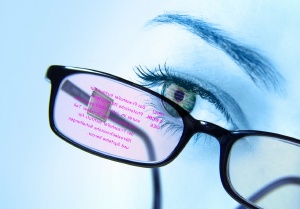Jun 2 2009
The data eyeglasses can read from the engineer's eyes which details he needs to see on the building plans. A CMOS chip with an eye tracker in the microdisplay makes this possible. The eyeglasses are connected to a PDA, display information and respond to commands.
 The data eyeglasses display information and respond to commands.
© Fraunhofer IPMS
The data eyeglasses display information and respond to commands.
© Fraunhofer IPMS
For car designers, secret agents in the movies and jet fighter pilots, data eyeglasses – also called head-mounted displays, or HMDs for short – are everyday objects. They transport the wearer into virtual worlds or provide the user with data from the real environment. At present these devices can only display information. “We want to make the eyeglasses bidirectional and interactive so that new areas of application can be opened up,” says Dr. Michael Scholles, business unit manager at the Fraunhofer Institute for Photonic Microsystems IPMS in Dresden. A group of scientists at IPMS is working on a device which incorporates eye tracking – users can influence the content presented by moving their eyes or fixing on certain points in the image. Without having to use any other devices to enter instructions, the wearer can display new content, scroll through the menu or shift picture elements. Scholles believes that the bidirectional data eyeglasses will yield advantages wherever people need to consult additional information but do not have their hands free to operate a keyboard or mouse. The Dresden-based researchers have integrated their system’s eye tracker and image reproduction on a CMOS chip. This makes the HMDs small, light, easy to manufacture and inexpensive.
The chip measuring 19.3 by 17 millimeters is fitted on the prototype eyeglasses behind the hinge on the temple. From the temple the image on the microdisplay is projected onto the retina of the user so that it appears to be viewed from a distance of about one meter. The image has to outshine the ambient light to ensure that it can be seen clearly against changing and highly contrasting backgrounds. For this reason the research scientists use OLEDs, organic light-emitting diodes, to produce microdisplays of particularly high luminance.
In industry and in the medical field, the interactive data eyeglasses could enable numerous tasks to be performed more simply, efficiently and precisely. Many scenarios are possible, including patients’ vital functions, MRT and x-ray images for the operating surgeon, construction drawings for erection engineers and installation instructions for service technicians. Some users have already tried out conventional HMDs, but the results were not very impressive. In most cases they were found to be too expensive, too heavy, too bulky and not very ergonomic. “We have now overcome these hurdles,” says Scholles. With his team and colleagues from other Fraunhofer institutes he is already working on the next development stage of the bidirectional eyeglasses.